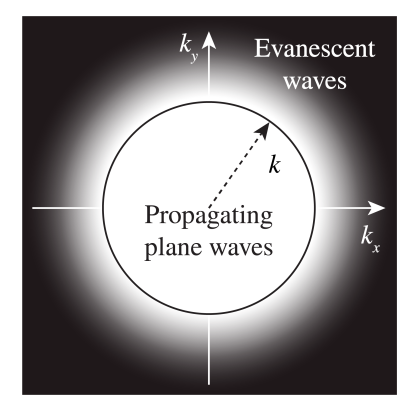6.4: Rayleigh-Sommerfeld Diffraction Integral
( \newcommand{\kernel}{\mathrm{null}\,}\)
Another method to propagate a wave field is by using the Rayleigh-Sommerfeld integral. A very good approximation of this integral states that each point in the plane z=0 emits spherical waves, and to find the field in a point (x,y,z), we have to add the contributions from all these point sources together. This corresponds to the Huygens-Fresnel principle postulated earlier in Section 5.6. Because a more rigorous derivation starting from the Helmholtz equation would be complicated and lengthy, we will just give the final result: U(x,y,z)=1iλ∬U(x′,y′,0)zeik√(x−x′)2+(y−y′)2+z2(x−x′)2+(y−y′)2+z2 dx′dy′=1iλ∬U(x′,y′,0)zeikrr dx′dy′ where we defined r=√(x−x′)2+(y−y′)2+z2.

Remarks.
- The formula ( 6.4.1 ) is not completely rigorous: a term that is a factor 1/(kr) smaller (and in practive is therefore is very much smaller) has been omitted.
- In ( 6.4.1 ) there is an additional factor z/r compared to the expressions for a time-harmonic spherical wave as given in (1.53) and at the right-hand side of (5.44). This factor means that the spherical waves in the Rayleigh-Sommerfeld diffraction integral have amplitudes that depend on the angle of radiation (although their wave front is spherical), the amplitude being largest in the forward direction.
- Equivalence of the two propagation methods. The angular spectrum method amounts to a multiplication by exp(izkz) in Fourier space, while the Rayleigh-Sommerfeld integral is a convolution. It is one of the properties of the Fourier transform that a multiplication in Fourier space corresponds to a convolution in real space and vice versa. Indeed a mathematical result called Weyl’s identity implies that the rigorous version of ( 6.4.1 ) and the plane wave expansion (i.e. angular spectrum method) give identical results.

